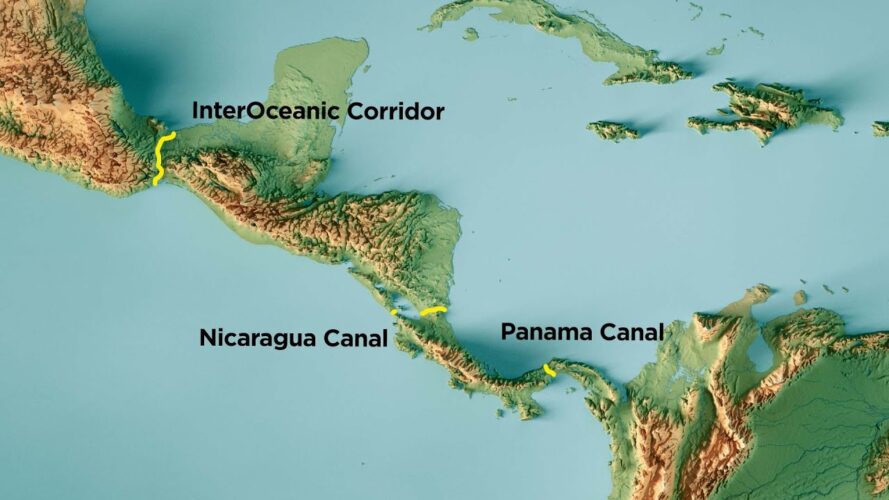We’re hearing a lot more about the Panama Canal lately regarding some presidential statements over whether the US should control it. But with cargo shipping at an all time high and still climbing, the Canal is more important than ever, and it’s also at it’s limits. For this reason there’s not just one but two new Central American canals in the works that could both speed up shipping and shift the balance of power in the world.
TRANSCRIPT:
I’ve said it before and I’ll say it again, the geography of the Americas is a bad joke.
Imagine you’re a merchant in Europe a couple hundred years ago, and you need to get your ships to Asia for those sweet, sweet spices. You could traverse the largest continent on Earth on the back of camels, or sail all the way around Africa. Both very dangerous and expensive. Or… Just go west.
Because you know the world’s round, despite what people in the future will say about you.
The problem is when you go west, there’s this ridiculous, skinny continent that stretches from north to south pole, and just to add insult to injury, it narrows down to only 80 kilometers wide at one point.
Just mocking you at this point, that’s just rude.
And it’s impenetrable, there’s mountains, there’s rain forests, there’s mosquitoes spreading Malaria, poison frogs spreading… poison.
You could sail thousands of miles to get around it all but the north route is covered with ice and the southern route Is covered with nightmares.
It would take hundreds of years before technology made it possible to build the Panama canal, at the cost of hundreds of lives.
But since then, the amount of commercial shipping around the world has increased exponentially. In fact, it’s gone up 300% just since 1992.
And yet, there’s still just one way through this continental middle finger to global commerce.
But what if there were more?
In the chaos following the inauguration of Donald Trump, a lot of announcements were made. Some we kinda expected, others… Not so much.
This caught a lot of us by surprise. But it has refocused a lot of attention on the Panama Canal as one of the most important and strategic locations on Earth when it comes to defense and shipping.
We live in a globalized economy where supply chains of countless industries rely on shipping parts from one side of the planet to the other. Granted a lot of that is done by air these days but still the cheapest way to move these things around are on container ships.
The Panama Canal is a lucrative and critical part of the world’s supply chain. The reason the President wants the Canal is because he thinks China has taken control of it.
Brace yourself…
that’s not true.
Don’t get me wrong, they have a stake in the canal, absolutely. Chinese companies like CK Hutchison have contracts to operate some of the ports but they don’t own the deed to them.
They can’t just start stacking hotels on the locks and charging ships for stopping on them.
But still, some in the current Presidential administration are worried China could take control of the canal by taking over private companies.
Ironically, since he signaled his intentions for the Panama Canal, the opposite has started happening. For instance, Blackrock just agreed to buy some of the ports from a Chinese company for $19 billion.
And despite the rhetoric, the US still has a huge presence in the Canal.
40 percent of America’s containers are shipped through the Canal…
and almost three-quarters of the cargo ships that move through the canal are coming from or to America, amounting to $4 trillion worth of goods.
But the Panama Canal is brittle. Disruptions range from obvious problems like…
dock worker strikes and…
and spikes in global fuel prices that make it more expensive to move goods to….
in-direct issues like wars that create shifts in trade routes.
But the biggest problem at the Panama Canal is droughts that have reduced lake levels and created havoc with ships in the locks.
A big part of the canal design is Gatun Lake, which is an artificial lake created by the Gatun Dam, across the Chagras river.
Gatun Lake sits 89 feet above sea level and ships have to go through a series of locks to get up to the level of the lake so they can sail across it, but those locks are fed by water from the lake. Which is fed by the Chagras River, which is fed by rainwater.
So when droughts hit the area, there’s not enough water in the lake for the locks to work properly, which is exactly what happened during a drought last year.
It created a logjam of 89 vessels clogging up hundreds of billions of goods. And you think you have constipation problems.
The canal’s chief sustainability officer said 2023 was the second driest year for the Panama Canal. The water level was 1 and a half meters shorter than usual.
Then there’s the canal’s age.
It’s over 100 years old and it’s gonna need more than an artificial hip and blood thinners to get it back in shape.
The canal’s equipment and locks have undergone expensive upgrades like the one it got in 2019 but that’s not a complete guarantee for all of its problems.
The older it gets, the more the Canal’s equipment deteriorates and fails, creating more room for accidents. In 2023, a tugboat was pushed up against a closed lock gate by another ship before it could open, which caused more delays.
There have also been several near-misses between vessels and boats scraping against the edges of the canal causing even more damage.
So instead of spending a small fortune renovating the Panama Canal, what if we could just build a whole new one somewhere else?
The Nicaragua Canal may sound like Charlie Sheen’s pre-rehab nickname but it’s also a real proposal for a new canal.
I should point out that I’ve been saying, “New Panama Canals” which is a misnomer, I’m not talking about new canals in Panama, I mean new canals that could function like the Panama Canal
President Daniel Ortega announced the plan last year. It’s 170 miles long from Puerto Corinto to Puerto de Bluefields. It runs through Lake Xolotlan [or Lake Mangua] but it would still need another artificial lake to fuel the locks on both sides of it.
It’s also 18 meters wider than the Panama Canal, three times as long and twice as deep.
Sounds like a perfect replacement, right?
Of course there are issues.
For one thing, it would cost at least $64 billion to build. That’s a pretty big lift for a country whose entire GDP is barely a quarter of that.
So of course they need to seek out funding, which they’ve been struggling with for more than a decade now.
By the way, this isn’t Nicaragua’s first attempt at this. In fact, there have been proposals around this since the early 1800s. This was a competing plan to The Panama Canal.
The U.S. aaaalmost decided to build through Nicaragua because the construction of the Panama Canal was kinda turning into a disaster.
The project was started by French engineers, but they got mired in the difficult terrain and just massacred by malaria. 22,000 French workers died – again you can watch my other video for all the details but suffice to say Panama was not going well.
So the U.S., wanting to build their own canal, started looking at Nicaragua. There was just one problem with Nicaragua as they saw it… They had a small infestation of volcanoes.
At least, that’s what they got convinced of.
A lobby led by a French engineer named Philippe Buanu-Varilla didn’t want Nicaragua to win the bid because they’d been working on the Panama Canal for a couple of decades at that point and they wanted to see it through.
A little sunk cost fallacy maybe.
So these guys teamed up with attorney William Nelson Cromwell to convince Congress to build his project in Panama.
They started a mail campaign to Senators where they mailed letters trying to talk them out of the Nicaragua plan and they chose a sneaky way to get the message across.
They sent the letters with a Nicaraguan stamp that featured the construction of its railroad. And right behind the railroad in the picture was a smoking Mt. Momotombo. Subtle guys.
Yeah. A stamp freaked them out.
Imagine being scared by a postage stamp.
Elvis is on a stamp?!? The dead are rising!
It didn’t help that in 1902, a volcano erupted in the Caribbean killing 30,000 people. Congress freaked out and backed the Panama Canal instead.
And then after the Panama Canal was finished, it all kinda seemed like a solved problem. And there’s just never been enough interest to make it happen.
But with the drastic increase in shipping traffic and all the problems at the Panama Canal, that’s started to change.
Nicaragua’s President is trying to negotiate a deal with China to construct the canal but it’s not looking good.
They actually broke ground on the project more than a decade ago, with funding from a Hong Kong investment company but the deal fell apart.
President Ortega submitted a new proposal in November to a group of potential investors but no one’s biting.
Critics of the proposal also say the Canal isn’t a feasible plan. There’s concerns about the environmental impact and displacing thousands of families to build the thing.
Which, thousands were displaced and died building the Panama Canal, but those were different times I guess.
There’s also a lot of unanswered questions about if there’s enough water in the region to support a canal.
Some have even suggested that the whole thing is just a distraction from Ortega’s human rights abuses. Of which there are many.
Ortega and co-president Rosario Murillo are being investigated by the U.S. Trade Representative and an international human rights court for every kind of bad thing a dictatorial regime can do. They’re accused of making politically motivated arrests, mass deportations that amount to human trafficking, forced labor and more.
Amnesty International accuses Ortega and Murillo of using their power “to intimidate, punish and eradicate any form of political opposition or defense of human rights.”
Gee, I wonder why nobody wants to get into business with these guys…
So for now it looks like Nicaragua’s canal isn’t going to be breaking ground anytime soon. But… the need for it is growing. So there’s a lot more people talking about it then there used to be.
What else is out there?
There’s another proposal for a canal in southern Mexico called the Interoceanic Corridor of the Isthumus of Tehuantepec.
It was first proposed two years ago with ports running from Coatzacoalcos to Salina Cruz.
The canal would be 188 miles long and will cost at least 2 billion pesos or approximately $97.1 million for the first two years of construction.
It’s also estimated it could move 1.4 million containers a year.
This idea goes back to the 16th century. Spanish conquistador Hernan Cortes wrote in letters that he thought it would make for a good canal route.
Then as Spain took over the region, they started surveying the isthmus with a canal in mind and eventually in 1814 they issued a decree to build the canal. But by the time work would get started on it, Mexico became an independent nation.
Work officially started in 1842 under businessman Jose de Garay. It took a year to recruit 300 convicts to do the work. But revolutions pushed back the start date until the funding ran out.
Six years and one Mexican-American War later, the U.S. showed an interest in building the canal.
America won California from Mexico right before the big Gold Rush providing a new funding source for construction. Unfortunately, both countries would need a peace treaty to use the route and wars tend to make peace treaties hard to achieve.
The project went from business to business. Time and again, they would try to attract investors only to fail or face political pushback and pass the concession along to another company.
And then, eventually, the Panama Canal opened, and actually by that point, railways were running cargo across Mexico, and the project was abandoned.
Until now.
And it’s a perfect idea for a new canal that will solve all of the world’s shipping problems.
First, the canal’s ports would need significant upgrades, which could drive up the price by billions of pesos.
The route of the canal wouldn’t be one long stretch of water. Cargo would still have to be loaded on trains to finish the route, which adds time, manpower, you name it.
The area’s also plagued with the same issues as the other two when it comes to the threat of water shortages, which could cause all kinds of delays.
There are also concerns about land rights and the environment.
The people who live along the route would be displaced and the government is trying to buy the land from them for absurdly low amounts. And this in a part of the world where poverty is extremely high.
The canal’s construction could also contaminate the air, water and soil in the region and would wipe out entire ecosystems.
So yeah, second verse same as the first. The interest is there, just not all the way there.
There is a third option to replace the Panama Canal, and it’s name… is the Panama Canal.
I mean, if those two canals aren’t feasible, then what about improving the working canal we already have?
Crews expanded the Panama Canal in 2019 with locks that are 21 meters wider and 5 meters deeper. The project also added two new sets of locks to the Atlantic and Pacific sides.
There are also ideas floating around to fix the low water levels in the canal. Last year, there was a proposal to build a new dam for the Río Indio river that runs southwest of Lake Gatún.
Unfortunately, the dam would flood the homes of 2,000 people who are already living well below the poverty line in the region. The region would also need to dam more rivers to create more water sources leading to more displacement, etc. etc.
Of course I can’t help but think that with all the money to be made by the canal, I can’t imagine they couldn’t afford to pay these people handsomely.
It’s not an easy problem to fix and the solution is going to be unbelievably hard to balance where the risk and benefit equals out for everyone affected by it.
Let’s say the absolute worst happens and the Panama Canal utterly failed. It would be a devastating economic and environmental loss for the region and even the world.
The effects of climate change will definitely lead to more droughts. That means even lower water levels, which means less ships would be able to pass through the canal.
America also pulled out of the Paris Climate Accords again, which is probably the minimum any industrialized nation can do to fight climate change.
It’s hard to get some of our own leaders to acknowledge that the words “climate” and “change” can sit next to each other in a sentence. So it’s not going to get better anytime soon.
An alternate canal could provide some additional routes if water levels sank to a dangerous level but it doesn’t look like there’s much progress in getting one built.
People have also floated around the idea of creating more rain by cloudseeding in the region, but it’s not known if it would work in tropical climates like Panama, and besides, that’s a temporary fix.
Here’s a glimmer of hope in an otherwise dull bubble of bleh. Some of the fixes and additions to the canal are working. The Panama Canal has 18 new water basins installed in its most recent expansion that can recycle 60 percent of the water it uses.
New initiatives like the canal authority’s Green Connection Environmental Recognition Program are showing how the canal can reduce fuel usage and create less greenhouse gases.
Maybe that will spur nations and corporations to further its upkeep efforts and make the Canal more efficient and usable.
The Canal has even created some benefits beyond economic positives that boosted Panama’s economy over the last century.
It led to the creation of the Chagres National Park that helps protect surrounding rivers. It’s not only good for the environment but it helps feed the lakes that power the canal’s locks.
Maybe those positives could move to the creation of a new canal but it’s not without sacrifice.
Even if Trump’s plans to acquire the Panama Canal doesn’t work, it’s grabbed our attention and gets us to look and think of ways it can be improved.
Because there are problems in the Panama Canal, just not the ones he’s talking about. And if we did take it over somehow, those problems aren’t going to go away, in fact, it could cost a lot of money to fix.
And besides, at least people are talking about the Panama Canal, which is itself a microcosm of bigger problems like rolling droughts and the economic effects of climate change. And maybe that could inspire more calls to action.
Look at me, being positive.




Add comment